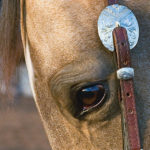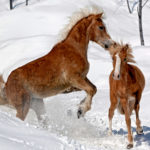It’s a beautiful day, perfect for a trail ride on your favorite horse. You grab a few items, saddle up, and look forward to an hour or two of some blissful outdoor R&R.

Is that the result you’re likely to get? It depends. Going out on trails simply isn’t as secure and predictable as riding in an arena, and that’s true even of the most familiar trail you ride. You can have a problem or make a wrong judgment call just as easily when you’re half a mile from home as you can while riding the backcountry. The key is to be prepared, be alert, and keep small mishaps from escalating.
Though you can’t predict everything that might happen on your rides, you can learn and practice fundamental trail smarts that’ll boost your safety and perhaps even help you get out of a jam. Rate your trail savvy by taking the test that follows. We’ll help you brush up in areas where you may find yourself to be lacking.
1. Your horn bag has an exterior pocket for carrying a beverage. You take:
A: A bottle of water.
B: An energy drink.
C: A beer or wine cooler.
2. You ride with a cell phone in case of emergency. You carry it:
A: In a belt holster.
B: In a saddle bag.
C: In your hand.
3. Your horse’s trail-riding headgear consists of:
A: His bridle, placed over his halter.
B: Bridle only; you carry a halter.
C: Bridle only, no halter.
4. Your own headgear consists of:
A: A protective riding helmet.
B: A Western hat or ball cap.
C: Nothing, your head is bare.
5. You pack a pair of saddlebags with supplies for a full day’s ride. You:
A: Balance the bags by weight, using a scale.
B: Put food in one bag and all else in the other.
C: Fill one side; use the other for trash.
6. When you go out alone, you always:
A: Leave word with someone.
B: Carry a cell phone.
C: Do neither of the above.
7.A fallen tree blocks your trail, so you:
A: Assess from horseback; turn back if necessary.
B: Attempt to get around the tree by going off-trail.
C: See if you can get your horse to jump it.
8. At a trailhead, your horse backs out of the trailer minus a shoe. You:
A: Apply a pre-sized protective hoof boot.
B: Improvise something with duct tape.
C: Ride your horse with his bare foot.
9. Your group stops as one rider tightens her cinch. You:
A: Keep your horse clear of others as you wait.
B: Pass around some snacks.
C: Hook a knee over the pommel and rest.
10. Your horse balks at muddy footing. You:
A: Assess first, then decide what to do.
B: Kick or spur your horse forward.
C: Dismount and lead him across.
What’s your score? Give yourself 10 points for every answer (A), five points for every answer (B), and zero points for every answer (C). If your score was 80 or over, you’re in the ranks of savvy trail riders. Not only do you have trail experience, you also possess ingenuity and an awareness of unnecessary risks. If your score was between 50 and 75, your savvy is so-so. You take risks that can make things go bad quickly. Zero to 45 points? You’re a trail wreck waiting to happen. You’re either nonchalant about your safety and that of others, or a rookie who needs a good trail mentor.
Choices Vs. Outcomes
Let’s review the scenarios you were quizzed on, so you can see how your choices often affect outcomes on the trail.
Trail beverage: Water wins you the full 10 points because it can serve multiple purposes beyond your own hydration. With water, you can clean a cut, swallow or dissolve meds, soothe a sunburn, and cool yourself or your horse. Water belongs on every trail rider’s must-take list. An energy drink simply isn’t as smart a choice. You can replace its quick-energy properties easily by eating a protein or granola bar before your ride. Alcohol…do we even need to say it? Drinking and riding never mix, alone or in mixed company.
Cell-phone carry: You’re best off to keep your phone on your person, secured so it doesn’t jostle off. (An open shirt pocket doesn’t qualify!) That way, you still have access to it should you and your horse part company. Even if you still have hold of your horse, you don’t want to be fumbling at saddlebag enclosures to reach your phone in a true emergency. Riding with your phone or anything else in your free hand is a flunk-out move. It’s easy to lose the device if your horse spooks or bucks, and you also lose use of the hand for controlling your horse or grabbing the saddle horn.
Horse’s headgear: A halter worn under the bridle is the mark of a trail rider who thinks ahead and is ready to tie or hand off his horse at a moment’s notice. While you get five points for at least having a halter with you, tied somewhere on the saddle, you also risk losing your horse when you have to pull the bridle to halter him. And, you can’t respond as quickly to a situation that requires you to secure your horse. No halter at all? No score.
Your headgear: It’s a no-brainer for your brain: Helmet use protects it. A hat or ball cap is only a little better than nothing, with at least some sun protection. Sure, we all know that a helmet alone doesn’t guarantee your safety. Nevertheless, it’s hard to argue against a protective helmet’s value for trail riding, especially when horseback riding is among the leading sports for head injury. Combine distance of your head’s fall (about 8 feet from atop a horse) with chance for hard-object impact (rock, log, flying hoof), and you get a recipe for high risk.
Saddlebags: While it’s convenient and perhaps more sanitary to keep one bag dedicated to your food, those aren’t the only considerations. If you’re a savvy trail rider, you think of your horse’s back when loading a set of saddle bags, ensuring that the load is even on both sides. You also keep tally of what’s been removed or consumed, and readjust your saddlebags accordingly. Only a clueless rider uses her horse’s back as a one-sided tote for party beverages.
Riding alone: Let’s face it, this runs risk up all by itself, because there’s no one at hand to help you with any problems. If and when you do go out alone, your smartest option is to “file a flight plan” with someone who can initiate a search if anything keeps you from getting back. Leave word of where you’re going and when you expect to be back. State which horse you’re on, and something about what you’re wearing; these details can help someone find you in the event that you’re too hurt to ride or unconscious. While your phone may allow you to call for help, it won’t send someone looking for you, and may not work when or where you need it.
Tree blocks trail: The first rule here is, “Don’t make things worse.” You show good savvy by sizing up the variables before making a next move. Can the tree be moved so you can get by? Are you in a place where you can safely dismount/remount? Does your horse tie reliably? Are there other riders to worry about? The safest call is to turn around. Depending on the trail’s location, you may not be able ride safely off-trail to get around. Imagine, for instance, a steep bank that you’d need to climb, or bogging footing. In some areas, riding off-trail is forbidden due to fragile soils and potential for erosion. It’s dangerous to jump a treefall when it’s one so large that your horse can’t simply step over it.
Missing shoe: Have a spare; you do it with your truck and trailer, and as a savvy trail rider, you do likewise for your shod horse. A protective hoof boot, pre-sized to your horse, is a relatively inexpensive item of gear to have on hand. It’s one of those things you’re glad to have when you need it. A makeshift hoof covering offers some protection to your horse, perhaps enough to get him back to the barn without a bruised sole. If you go ahead and ride him with nothing in place of the shoe, you score zero on horsemanship as well as trail savvy.
Stopped group of riders: Bravo for the call to keep your horse safely separated when a group ride must be halted. Horses can get anxious or aggravated in this circumstance, and it’s not uncommon for them to kick at horses they don’t know. If you’re too close, your thigh or kneecap could take the blow. Always take care when passing snacks to a group of stopped riders, especially if you don’t know their horses or their skills. A crackling wrapper or dropped treat can easily spook a horse. That leg-over-pommel move? Seriously not smart. It leaves you halfway out of the saddle while it stresses your horse’s back.
Balking at mud (or water): This is another situation in which assessment is the best first move. Unless you know a crossing spot to be safe, your horse may have good reason for refusing to go forward. Some horses panic when mud sucks at their feet; your horse can unload you as he lunges to free himself. Be sure you won’t be getting in too deep—literally—before you try getting your horse to cross. Never try to lead your horse across mud or water. Chances are he’ll either pull back and get away from you, or knock you down as he makes a huge leap right behind your back.





